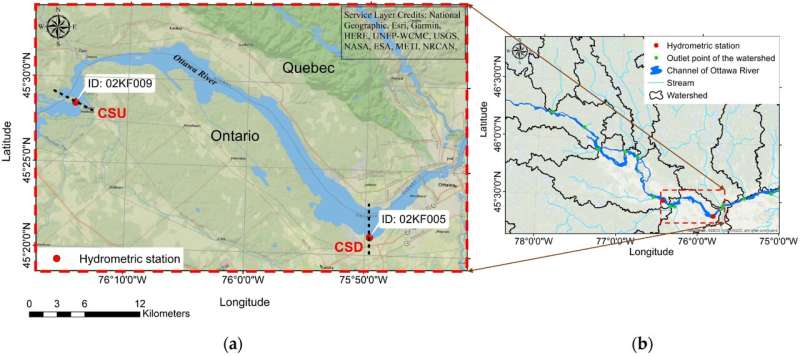
November 19, 2024 by Patrick Lejtenyi, Concordia University
Collected at: https://phys.org/news/2024-11-ai-river-discharge-potential.html
As recent flooding in Spain and elsewhere revealed, every minute of warning given to people ahead of a possible flood can save lives and property. A new paper published in the journal Hydrology may help authorities improve flood evacuation protocols with help from a machine-learning model developed by Concordia researchers.
Ph.D. candidate Mohamed Almetwally Ahmed and Samuel Li, professor and chair of the Department of Building, Civil and Environmental Engineering, created a method that uses artificial intelligence to more accurately predict short-term river discharge.
Using historical data and a novel set of weather-based predictors, the authors based their research on measuring advection—the rate of water movement—between two hydrometric stations on the Ottawa River. A test case was created using two stations roughly 30 kilometers apart. The downstream station had been deactivated for many years and the upstream station was still active.
Historical data collected over decades by the Government of Canada was supplemented by data on rainfall, temperature and humidity levels, among other parameters. Once input into the machine-learning model, these parameters provided reliable estimates on daily discharge and gave real-time data on how much water was moving through a particular cross-section in the river.
“Sub-diurnal forecasting, meaning less than 24 hours, is mainly used for evacuation. This method gives us more accurate forecast probabilities compared to those that make predictions daily or over multiple days,” Ahmed says. “These are all based on probabilities, and the probability increases as the forecasting time decreases.”
A transparent and transferrable model
The researchers built on an existing type of algorithm called group method of data handling. This method constructs predictive models by sorting and combining data into groups, where they are computed in different combinations repeatedly until the best and most reliable data combination is identified.
“In this method, we use nine predictors: seven weather parameters and the historical data from the two hydroelectric stations. The model ranks and re-sorts these parameters to create multiple combinations until it makes a digital selection of predictors. It is important to note that it does not necessarily use all the predictors or weigh them equally. It uses the ones that prove to be the most accurate,” Ahmed explains.
The model changes depending on time frame. One that predicts discharge 12 hours ahead will be different than one that predicts eight, nine or 10 hours ahead.
The model also changes from river to river. To test it, Ahmed conducted additional calculations on data taken from the Boise and Missouri rivers in the United States.
“As this technique matures, we think we will be able to run it in an operational kind of way, where people will be able to check river discharge estimates on their phones, just like they do a weather forecast,” Li says. “Instead of giving them the estimates for temperatures or rainfall at some point in the future, we can give them the water levels.”
To Ahmed, who is pursuing his studies in flood evacuation preparedness, this model is only one tool he hopes authorities can use ahead of disastrous flooding.
“I want them to use this data as an input for their models for flood-prone areas,” he says. “With this tool, we can help them predict which roads will be available for evacuation, which would give the local transportation system real-time action plans that can save lives and property.”
More information: M. Almetwally Ahmed et al, Machine Learning Model for River Discharge Forecast: A Case Study of the Ottawa River in Canada, Hydrology (2024). DOI: 10.3390/hydrology11090151

Leave a Reply